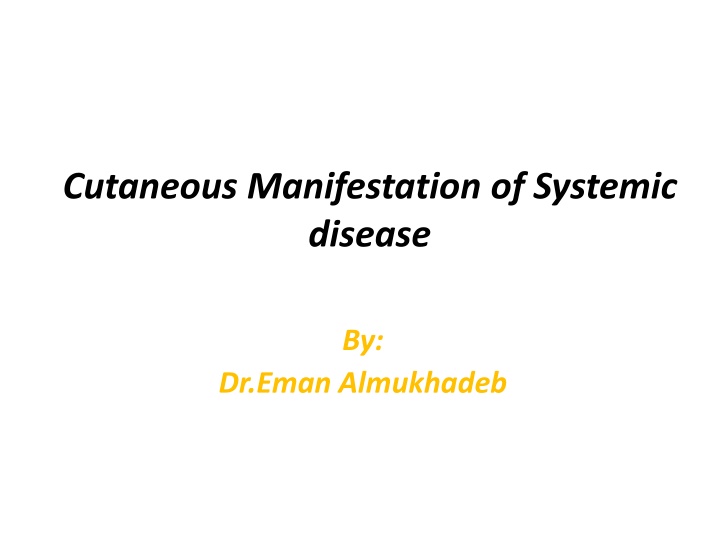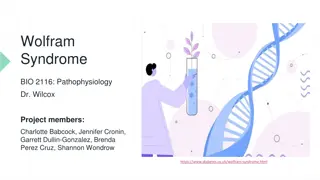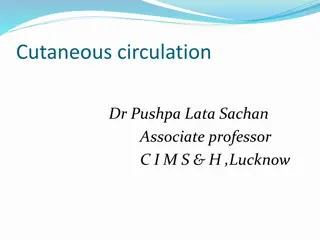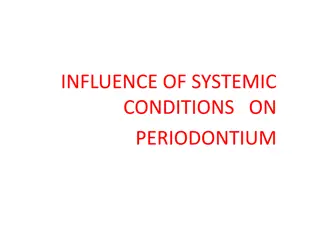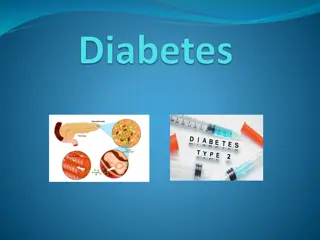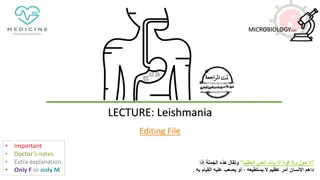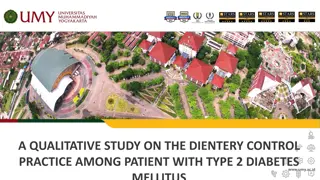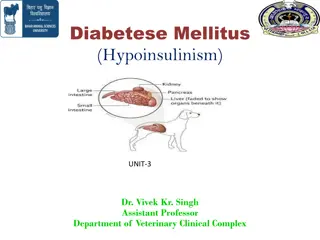Cutaneous Manifestations of Systemic Diseases: Endocrine Disorders and Diabetes Mellitus
Explore the cutaneous manifestations of systemic diseases, particularly focusing on endocrine disorders like diabetes mellitus. Learn about the dermatologic signs associated with conditions such as hypothyroidism, hyperthyroidism, Addison's disease, and Cushing syndrome. Discover specific manifestations of diabetes mellitus like diabetic dermopathy, necrobiosis lipoidica, acanthosis nigricans, and more. Dive into the clinical characteristics, prevalence, pathological features, and treatment options for these conditions.
Download Presentation

Please find below an Image/Link to download the presentation.
The content on the website is provided AS IS for your information and personal use only. It may not be sold, licensed, or shared on other websites without obtaining consent from the author.If you encounter any issues during the download, it is possible that the publisher has removed the file from their server.
You are allowed to download the files provided on this website for personal or commercial use, subject to the condition that they are used lawfully. All files are the property of their respective owners.
The content on the website is provided AS IS for your information and personal use only. It may not be sold, licensed, or shared on other websites without obtaining consent from the author.
E N D
Presentation Transcript
Cutaneous Manifestation of Systemic disease By: Dr.Eman Almukhadeb
Introduction -CUTANEOUS MANIFESTATIONS OF : -Endocrine disorders -Metabolic disorders (Hyperlipoproteinemias ) -GIT disorders -Liver cirrhosis -Renal failure
CUTANEOUS MANIFESTATIONS OF ENDOCRINE DISORDERS
CUTANEOUS MANIFESTATIONS OF ENDOCRINE DISORDERS Cutaneous Manifestation of : - Diabetes Mellitus - Hypothyroidism - Hyperthyroidism - Addison s disease - Cushing syndrome
CUTANEOUS MANIFESTATIONS OF DIABETES MELLITUS - Diabetic dermopathy - Necrobiosis Lipoidica - Acanthosis nigricans - Bullous diabeticorum - Generalised granuloma annulare - Scleredema Diabeticorum - Bacterial and fungal infections - OTHER: Perforating dermatosis , Skin tags , eruptive xanthomas , neuropathic ulcers
1-Diabetic Dermopathy or Shin Spots Most common cutaneous manifestation of diabetes; M > F, males over age 50 years with long standing diabetes - Possibly related to diabetic neuropathy and vasculopathy There are bilateral asymptomatic red-brown atrophic macules on shins There is no effective treatment
2-Necrobiosis Lipoidica (NLD) Patients classically present with single or multiple red-brown papules, which progress to sharply demarcated yellow-brown atrophic, telangiectatic plaques with a violaceous,irregular border. -Common sites include shins followed by ankles, calves, thighs and feet. -Ulceration occurs in about 35% of cases. Cutaneous anesthesia, hypohidrosis and partial alopecia can be found Pathology: Palisading granulomas containing degenerating collagen (necrobiosis).
NLD Approximately 60% of NLD patients have diabetes & 20% have glucose intolerance. Conversely , up to 3% of diabetics have NLD. -Women are more affected than men. -Pathogenesis is thought to involve the nonenzymatic glycosylation of dermal collagen and elastin Treatment: Ulcer prevention, No impact of tight glucose control on likelihood of developing NLD. -Intralesional steroids - Aspirin -Antiplatelet -Pentoxyfylline. -Preilesional heparin injection
3-Acanthosis Nigricans -Causes: -obesity & insulin resistance & endocrinopathy (DM ,acromegaly ,cushing syndrome ,hypothyroidisim & hyperandrogenic state as HAIRAN syndrome (hyperandrogen, insulin resistance, acanthosis nigricans) -Malignancy (esp. GIT, Lung & Breast CA) -Medications (nicotinic acid ,niacinamide , testosterone, OCP & Glucocorticoid)
Acanthosis nigricans Clinical picture: Hyperpigmented velvety plaques of the flexures. The face, external genitalia, medial thighs, dorsal joints, lips and umbilicus can be involved in extensive cases
3-Acanthosis Nigricans Pathogenesis involves: Genetic sensitivity of the skin to hyperinsulinemia Aberrant keratinocyte and fibroblast proliferation stimulated by excess growth factor(e.g., Insulin like growth factor) Treatment: Treat the underlying cause : -Tight blood glucose control, -treatment of underlying malignancy, -weight control -discontinuation of offending agent
4-Diabetic Bullae or Bullae Diabeticorum Rarest cutaneous complications of diabetes; M > F, long standing diabetics. -Trauma and microangiopathy may play a role Clinical: Rapid onset of painless tense blisters on the hands and feet Pathology: Intraepidermal and/or subepidermal split without acantholysis. DIF is negative Treatment: Spontaneous healing without scarring
5-Granuloma Annulare Association between granuloma annulare and diabetes is controversial. -Generalized form of GA is the most closely associated with DM. -It has a chronic and relapsing course Treatment : IL steroid Systemic steroid PUVA Asymptomatic red-purple dome shaped papules arranged in annular configuration
6-Scleredema Diabeticorum Occurs diabetics with poorly controlled , long-standing disease, and obese men Painless, symmetric woody peau d orange induration of the upper back and neck. -No specific treatment is available -Control of hyperglycemia does not improve the scleredema
7-Cutaneous Infections Diabetic patients are predisposed to develop cutaneous infections due to poor microcirculation -Bacterial -Fungal
Other manifestation of DM: -Diabetic neuropathy (peripheral) ,Neuropathic ulcers Eruptive Xanthomas
Non-specific Manifestations of Hyperthyroidism Skin Warm, and moist Palmar erythema Flushing of head/neck, trunk Hair Soft/fine/straight Diffuse reversible alopecia (Telogen effluvium) Nails Faster rate of growth Onycholysis Plummer nails: concave deformity with distal onycholysis Pigmentation Focal or generalized hyperpigmentation Vitiligo
Thyroid dermopathy (Pretibial Myxedema): -Bilateral, non-pitting yellowish- brown to red waxy papules, nodules and plaques on the shins - Occur in Graves disease. -The clinical findings are due to an increase in (mucin) hyaluronic acid in dermis. - Treatment regimens include high potency topical steroids & intralesional steroid.
Non-specific Manifestations of Hypothyroidism Skin Cool, dry, pale Xerosis Hypohidrosis Yellowish hue secondary to carotenemia Generalized myxedema: swollen waxy appearance Swollen lips, broad nose, macroglossia Purpura secondary to impaired wound healing Hair Dry, brittle, coarse hair Diffuse alopecia, Telogen effluvium Loss of lateral third of eyebrow (madarosis)
Hypocorticism (Addison disease): -Generalized hyperpigmentation that is more prominent in light exposed areas, scars, genitalia, palmar and finger creases, and under the nails. The pigmentation characteristically affects the mucous membranes. -Loss of pubic and axillary hair in females. -Improvement of acne
Cushing syndrome: -endogenous or exogenous -Deposition of fat over the clavicles and back of the neck Buffalo hump -Rounded erythematosus face with telangiectasia Moon face -Truncal obesity with slender wasting limbs. -Striae distensae -Hirsutism, acneform rash, androgenetic alopecia. -Easy bruising of the skin on simple trauma.
Hyperlipoproteinemia Type I Familial lipoprotein lipase deficiency (AR) or apoprotein CII deficiency Increased chylomicrons Associated with hepatomegaly, pancreatitis Type IIa Familial hypercholesterolemia, common hypercholesterolemia (AD) Increased LDL Type IIb Familial hypercholesterolemia (AD) Increased LDL and VLDL Type III Familial Dysbetalipoproteinemia (AR) Increased IDL Type IV Familial hypertriglyceridemia (AD) Increased VLDL Type V Familial type V hyperlipoproteinemia, familial lipoprotein lipase deficiency (AD) Increased chylomicrons and VLDL
Xanthomatosis 6 Clinical Types: Tuberous Xanthoma Tendinous Xanthoma Eruptive Xanthoma Planar Xanthoma Palmar Xanthoma Xanthelasma
1-Tuberous Xanthoma Flat or elevated, rounded, grouped, yellowish-orange nodules over joints (particularly elbows and knees) Types II, III, and IV Biliary cirrhosis 2-Tendinous Xanthoma Papules or nodules over tendons (extensor tendons on dorsum of hands, feet, and achilles) Types II, III 3-Eruptive Xanthoma Small yellow/orange/red papules appearing in crops over entire body buttocks, flexor surfaces, arms, thighs, knees, oral mucosa and may koebnerize Associated with markedly elevated or abrupt increase in triglycerides (elevated chylomicrons) Types l ,lll , lV , and V Diabetes, obesity, pancreatitis, chronic renal failure, hypothyroidism, estrogen therapy, corticosteroids, isotretinoin, acitretin Eruptive Xanthomas
Eruptive xanthomas. Note the yellowish hue Tuberous xanthomas of the knee. Note the yellowish hue.
Tendinous xanthoma. Linear swelling of the Achilles area representing a tendinous xanthoma in a patient with dysbetalipoproteinemia. Tendinous xanthomas of the fingers in a patient with homozygous familial hypercholesterolemia.
4-Planar Xanthoma Flat macules or slightly elevated plaques, yellow/tan color Associated with biliary cirrhosis, biliary atresia, myeloma, monoclonal gammopathy, lymphoma. Characteristically around eyelids, neck, trunk, shoulders, or axillae Types ll,lll 5-Palmar Xanthoma Nodules and irregular plaques on palms and flexural surfaces of fingers Type III 6-Xanthelasma Most common type of xanthoma Eyelids Usually present without any other disease, but can occur in types II and III Common among women with hepatic or biliary disorders, also seen in myxedema, diabetes Best treated with surgical excision Plane xanthoma in a patient with a monoclonal IgG gammopathy
Plane xanthomas of the palmar creases in a patient with dysbetalipoprotenemia (arrows). Xanthelasma palpebrarum with typical yellowish hue.
CUTANEOUS MANIFESTATIONS OF GASTROINTESTINAL DISORDERS
Association Cutaneous Findings Commonly involves perineum associated with edema and inflammation Fissures and Fistulas CD > UC Edema, cobblestone, ulcerations, nodules Oral Crohn s CD Nodules, plaques, ulcerations; commonly on extremities or intertrigenous regions mimics Erythema Nodosum Metastatic Crohn s CD Tender red nodules on anterior lower legs; precedes or occurs simultaneous with IBD flare Erythema nodosum UC>CD Papules, pustules, hemorrhagic blisters enlarge, ulcerate with dusky undermined edges; exacerbated by trauma; frequently on legs Pyoderma Gangrenosum (PG) UC>CD Vegetating plaques, vesiculopustules of intertrigenous areas; heal with hyperpigmentation; when process involves mucosa =Pyostomatits vegetans Pyoderma Vegetans UC Identical to common aphthous ulcers; develop with IBD flares Chronic Apthous Ulcers UC>CD Other less common manifestation: Epidermolysis bullosa acquisita, erythema multiforme, urticaria, clubbing, psoriasis, vitiligo. Note: CD = Crohn s disease ,UC = Ulcerative Colitis
Erythema Nodosum Erythematous, tender nodules on anterior shins; also seen on thighs, lateral aspects of lower legs, arms, and face , bilateral , symmetrical. Often accompanied by fever, chills, malaise, and leukocytosis 70% have associated arthropathy Occurs at any age, but most prevalent between 20 and 30 years of age
Erythema Nodosum Causes : MNEMONIC SHOUT BCG S=Sarcoid, Sulfa drugs, Strept. H=Histoplasmosis O=Oral contraceptives , pregnancy U=Ulcerative colitis T=TB B=Bechet s C=Crohns G=GI (Yersinia, salmonella )
Work up: -Hx ( exclude drugs , hx of infection & GI symptoms) -CBC ,diff. -ESR -Throat swab -ASO titre -CXR -PPD -Stool for occult blood
Histology Septal panniculitis without vasculitis
Erythema Nodosum Treatment Spontaneous resolution usually occurs within three to six weeks without scarring NSAIDs such as indomethacin or naproxen Systemic steroids effective in severe cases and can be dangerous if infection is etiology Potassium iodide
Pyoderma gangrenosum (PG) -1.5-5% of patients with IBD develop PG Associated with leukemia, myeloma, monoclonaL gammopathy (IgA), polycythemia, chronic active hepatitis, HCV , HIV , SLE & pregnancy Associated with PAPA syndrome pyogenic arthritis, pyoderma gangrenosum, severe cystic acne May be associated with arthritis
Pyoderma gangrenosum Four Types: Ulcerative Pustular Bullous Vegetative Distinct rolled edges and show satellite violaceous papules that break down and fuse with central ulcer
Pyoderma gangrenosum Histology Massive dermal edema with epidermal neutrophilic abscesses.
